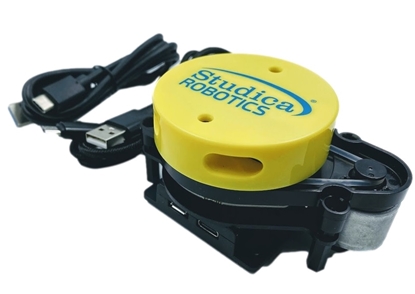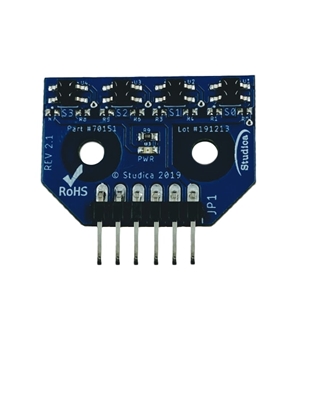Sensors
Sensors
360 Degree LiDAR
The Studica 360 Degree LiDAR is a 2D LiDAR that rotates 360 degrees to achieve high accuracy, stable performance, high-frequency and high-precision distance measurement. It's ideal for robot navigation and obstacle avoidance.
IR Range Sensor (10 cm to 80 cm) w/I2C female to TJC8 female cable
The IR Distance Sensor GP2Y0A21YK0F uses a beam of infrared light to reflect off an object to measure its distance. Because it uses triangulation of the beam of light to calculate the distance, it is able to provide consistent and reliable readings which are less sensitive to temperature variation or the object’s reflectivity. The sensor outputs an analog voltage corresponding to the distance of the object, and can easily be read using an inexpensive analog to digital converter (ADC) chip.
Includes 40cm I2C female to TJC8 female cable
Cobra Line Follower Sensor
The Cobra Line Follower Array provides 4 X QRE1113 IR reflectance sensor mounted on a 9mm pitch Each sensor is comprised of two parts - an IR emitting LED and an IR sensitive phototransistor. When you apply power to the VCC and GND pins the IR LED inside the sensor will illuminate.
The Studica Line Sensor Board consists of 4 IR LED/phototransistor pairs, making it a great detector for a line-following robot. The Line Sensor Board allows the robot to tell objects or surfaces apart based on how dark or light they are. It shines a beam of infrared light out onto the object, and measures how much light is reflected back.
Each sensor provides a separate analog voltage output. The sensor board is an infrared emitter/receiver that is able to differentiate between a dark surface (with low IR reflectivity – 3.3V to 5V) and a light surface (with high IR reflectivity – 0V to 0.5V). However, this range can vary depended on the installed height of the sensor board.
The optimum height distance is 3-5 mm; however, the reflectivity values will change depending on distance. A daylight filter is built into the sensor.
- 5VDC operating voltage (recommended)
- 70mA supply current
- Optimal sensing distance: 0.125" (3mm)
- Step File
Ultrasonic Distance Sensor
- Stable, accurate distance measurement
- High precision, blind spots (3cm) super close
- A full set of ranging process
- Step File
Short Lever Limit Switch (4 pack)
This is a snap-action micro switch with hinged roller lever and terminals for easy wire connection.
Features:
- High precision of action seat
- High shock resistance
- Shock resistance Max.l000/s2
- Max temperature: T105.C
- Catheter design for easy wiring
- 3 Pin
- Max. Current: 16A
- Max. Voltage: 250V
- OP:14.3~15.1mm
- Protection Level: IP40
- Switch Function: ON - (OFF), OFF - (ON)
- Contact form: SPDT
- High impact resisstance
- Max Ambient temperature:105centigrade
- Mechanical life:10,000,000 on -off
- Electrical life: over 100,000 on-off
- Contact material: AgNi ,AgCdO
- Certificate: CCC,CE,UL,ROHS

navX2-Micro Robotics Navigation Sensor
The navX2-Micro is the greatest sensor for orientation in competitive robots. navX2-Micro is a second-generation 9-axis inertial/magnetic sensor and motion processor. Designed for plug-n-play installation onto robots such as those used in the WorldSkills Robotics, FIRST Technology Challenge (FTC) and the FIRST Robotics Challenge (FRC), navX2-Micro helps build better robots by adding sophisticated navigation capabilities. Significant improvements over the classic navX-Micro allow for more accuracy, decreased yaw drift, and faster boot time. navX-2 Micro includes software algorithms for enhanced sensor calibration as well as KalmanFilter-based data fusion combining gyro, accelerometer, and magnetometer data into a 9-axis heading and high-quality magnetometer calibration including magnetic disturbance detection.
In addition to being an Inertial Measurement Unit, navX2-Micro capabilities are referred to within the aerospace industry as an “Attitude/Heading Reference System” (AHRS). Studica brings this high-tech AHRS capability to FIRST teams – to use, learn, and explore. navX2-Micro is a key component of Studica's ongoing efforts to make state-of-the-art navigation technologies used in drones and autonomous vehicles (e.g., the Google Car) available to robotics students and enthusiasts as low-cost, open-source products.
Improvements over navX "Classic":
navX2-Micro features a new set of IMU & Magnetometer sensors with superior sensor specifications to those on the MPU-9250 sensor. This board has a faster 180Mhz microcontroller and an optimized startup time at 5 seconds versus 15 seconds. In addition, it has a completely new Kalman Filter-based Sensor Fusion algorithm running internally at a blazing fast 416Hz.
RoboRIO Installation
It's recommended to connect to the RoboRIO using a USB Mini-B type (Male) to USB A type (Male) connector, navX2-Micro can receive both power and also communicate with the RoboRIO. This preferred installation method allows the navX2-Micro circuit board to be placed up to 6 meters away from the RoboRIO.
IMPORTANT NOTE: To avoid having the navX2-Micro reset due to a RoboRIO brownout, connecting the navX2-Micro to the RoboRIO via USB is highly recommended.
3D Depth Camera
Designed as a more affordable replacement for the RealSense D435, the Studica 3D Depth Camera provides an accurate high-definition depth-sensing camera for mobile robotics and consumer electronic projects.









